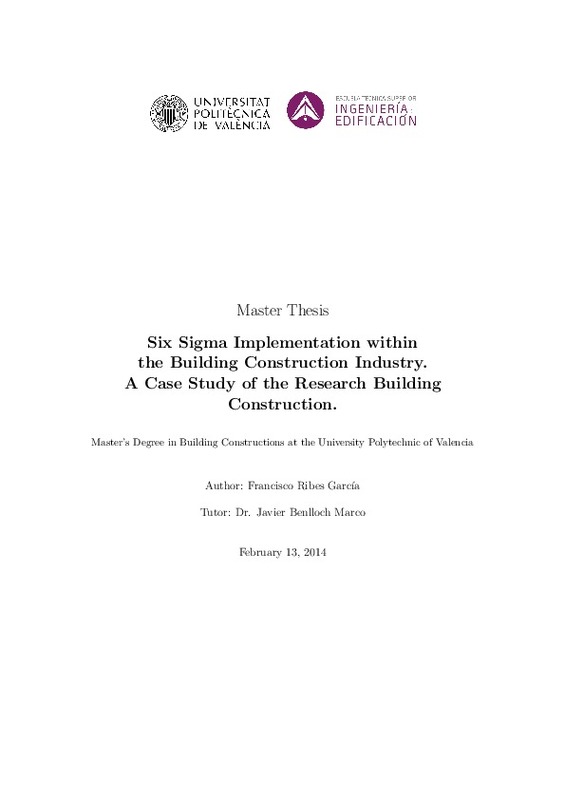JavaScript is disabled for your browser. Some features of this site may not work without it.
Buscar en RiuNet
Listar
Mi cuenta
Estadísticas
Ayuda RiuNet
Admin. UPV
Six Sigma implementation within the Building Construction Industry : a case study of the Research Building Construction
Mostrar el registro sencillo del ítem
Ficheros en el ítem
| dc.contributor.advisor | Benlloch Marco, Javier
|
es_ES |
| dc.contributor.author | Ribes García, Francisco
|
es_ES |
| dc.date.accessioned | 2014-10-31T11:47:48Z | |
| dc.date.available | 2014-10-31T11:47:48Z | |
| dc.date.created | 2014-02-24 | |
| dc.date.issued | 2014-10-31T11:47:48Z | |
| dc.identifier.uri | http://hdl.handle.net/10251/43751 | |
| dc.description.abstract | [EN] This Master of Science thesis is based on a research project on the implementation of Six Sigma within the Research Building Construction Industry. The case studies presented have been researched in Germany. Six Sigma consists in improving the projects mainly in terms of quality and also in terms of time management. According to the Six Sigma system, the goal is to detect the errors in those fields. This can consequently improve and optimise the projects, which have been already implemented with Six Sigma. Moreover, this system can also reduce the errors, and that means less work accidents and less extra money waste, by means of focusing on quality and time management. This system has already been implemented in different fields such as service, hospitality, finance, retail, automotive, media, manufacturing and in its first implementation in the year 1987, in the information technology industry by the company \Motorola". It is to be considered though that early delivery is not always profitable, owing to the possibility of a quality reduction in the final product of the project. For this reason, an equivalence must exist between time and quality. On the other hand, in the construction industry, every building is like a prototype for the automotive or information technology industry, and that means that improving time and quality in the Research Building Construction Industry can be quite difficult. However, this is not entirely the case, because the research of the Six Sigma implementation in that field demonstrates that Six Sigma is able to optimise and improve those common and specific projects in time and quality. | es_ES |
| dc.description.abstract | [es ] Este Proyecto Final de Máster consiste en un proyecto de investigación relativo a la implementación de Six Sigma en la Investigación en gestión de la edificación. En el proyecto se presentan una serie de casos investigados en Alemania. La filosofía Six Sigma se fundamenta en mejorar los proyectos fundamentalmente en términos de calidad, pero también en términos de gestión del tiempo. De acuerdo con el sistema Six Sigma, el objetivo es detectar errores en estos campos, lo que, consecuentemente mejora y optimiza los proyectos que ya han sido implemetados con Six Sigma. Además, este sistema puede reducir los errores lo que se traduce en menos accidentes laborales y en ahorro de costes mediante un enfoque centrado en la calidad y la gestión del tiempo. Este sistema ya ha sido implantado en diferentes áreas: servicios, empresas hosteleras, finanzas, comercio al por menor, automoción, medios de comunicación, fabricación de productos, etc., y fue aplicado por vez primera en 1987 por Motorola a la industria de las tecnologías de la comunicación. Además, hay que considerar que la entrega de un producto en el plazo más corto posible no siempre es rentable, a causa de la posibilidad de una reducción de la calidad del producto final. Por este motivo, es necesario postular una correlación entre tiempo y calidad. Por otra parte, en la industria de la construcción, cada edificación es como un prototipo en la industria de la automoción o en la industria de las tecnologías de la información, y esto quiere decir que mejorar en Investigación en Gestión de la Edificación puede ser dificultoso. Sin embargo, no es enteramente así, ya que la investigación en este campo con la implementación Six Sigma es capaz de optimizar y mejorar proyectos comunes y específicos en cuanto a tiempo y calidad. | es_ES |
| dc.format.extent | 56 | es_ES |
| dc.language | Inglés | es_ES |
| dc.publisher | Universitat Politècnica de València | es_ES |
| dc.rights | Reserva de todos los derechos | es_ES |
| dc.subject | Control de calidad | es_ES |
| dc.subject | Seis Sigma (Norma de control de calidad) | es_ES |
| dc.subject | Proyectos de arquitectura | es_ES |
| dc.subject.classification | CONSTRUCCIONES ARQUITECTONICAS | es_ES |
| dc.subject.other | Máster en Edificación especialidad Gestión-Màster en Edificació especialitat Gestió | es_ES |
| dc.title | Six Sigma implementation within the Building Construction Industry : a case study of the Research Building Construction | es_ES |
| dc.type | Tesis de máster | es_ES |
| dc.rights.accessRights | Abierto | es_ES |
| dc.contributor.affiliation | Universitat Politècnica de València. Escuela Técnica Superior de Gestión en la Edificación - Escola Tècnica Superior de Gestió en l'Edificació | es_ES |
| dc.description.bibliographicCitation | Ribes García, F. (2014). Six Sigma implementation within the Building Construction Industry : a case study of the Research Building Construction. http://hdl.handle.net/10251/43751. | es_ES |
| dc.description.accrualMethod | Archivo delegado | es_ES |
Este ítem aparece en la(s) siguiente(s) colección(ones)
-
ETSIE - Trabajos académicos [2326]
Escuela Técnica Superior de Ingenieria de Edificación






